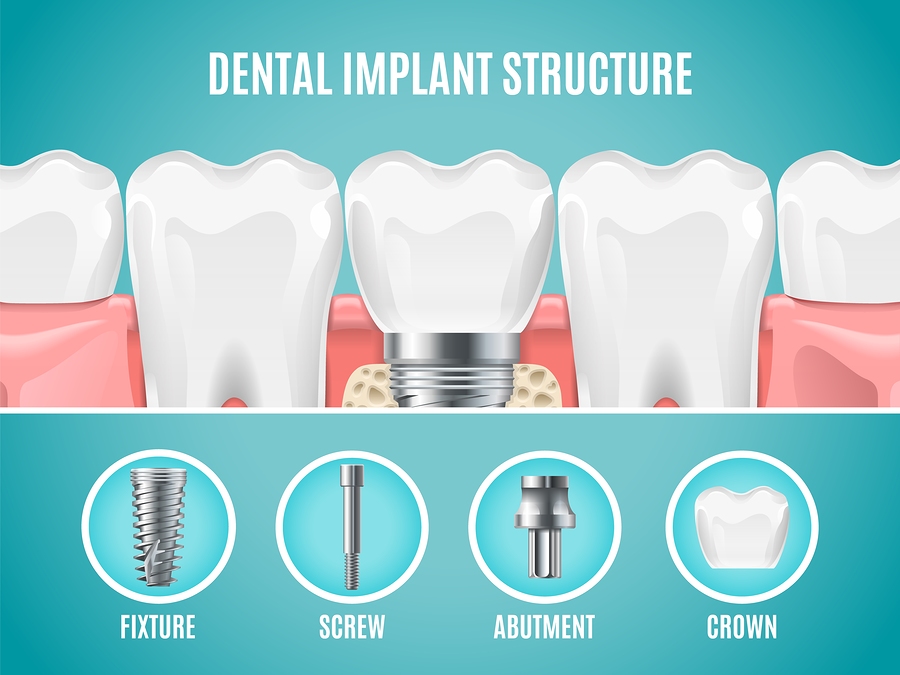The Ultimate Guide To Dental Sense
The 9-Minute Rule for Dental Sense
Table of ContentsSome Known Details About Dental Sense 4 Easy Facts About Dental Sense Shown9 Simple Techniques For Dental SenseMore About Dental Sense
are clinical gadgets surgically implanted into the jaw to restore a person's ability to eat or their appearance. They provide assistance for synthetic (fake) teeth, such as crowns, bridges, or dentures. When a tooth is lost due to injury or condition, a person can experience problems such as rapid bone loss, malfunctioning speech, or adjustments to eating patterns that cause pain.Oral implant systems consist of a dental implant body and oral implant abutment and might also include an abutment fixation screw. Dental veneers cost. The oral implant body is operatively placed in the jawbone instead of the tooth's root. The oral implant abutment is usually connected to the dental implant body by the joint fixation screw and prolongs via gums into the mouth to support the attached fabricated teeth
(https://moz.com/community/q/user/dentalsense1)Structure of The Dental Implant System picking dental implants, speak to your oral provider regarding the possible benefits and dangers, and whether you are a prospect for the procedure. Points to consider: Your overall health is an essential variable in figuring out whether you are a great candidate for dental implants, exactly how long it will require to recover, and how much time the implant may remain in location.
Cigarette smoking might influence the healing procedure and lower the long-term success of the dental implant. The healing process for the implant body may take several months or longer, during which time you generally have a short-lived joint in area of the tooth. the oral implant treatment: Thoroughly comply with the dental health instructions offered to you by your oral supplier.
Unknown Facts About Dental Sense
Implant failure can cause the demand for an additional surgery to repair or change the dental implant system. Restores the ability to eat Restores aesthetic look Aids keep the jawbone from shrinking as a result of bone loss Preserves the health and wellness of the surrounding bone and periodontals Aids keep adjacent (nearby) teeth steady Improves quality of life Damages to bordering all-natural teeth throughout implant placement Injury to the surrounding cells during surgical procedure, such as sinus perforation Injury throughout surgical treatment (for instance, fracture of surrounding jawbone) Poor function, such as seeming like the teeth do not bite with each other generally A sensation that the tooth hangs or turning in position resulting from a joint screw loosening up Implant body failure (looseness of the implant body) as a result of systemic infection, which may be much more most likely in individuals with uncontrolled diabetes mellitus as a result of regional infection in bone and gum tissues sustaining the dental implant body because of postponed recovery, which may be much more most likely in clients that smoke Difficulty cleaning up the periodontals around the dental implant, resulting in inadequate oral hygiene Neglected periodontal illness Post-surgical feeling numb due to nerve impingement or damage Constantly notify health treatment suppliers and imaging professionals that you have dental implants before any magnetic resonance imaging (MRI) or x-ray procedures.
FDA is not familiar with any unfavorable occasions reported for MRI or x-ray treatments with oral implants. Dental implants systems are typically constructed from products that adhere to global agreement requirements of the International Organization for Standardization (ISO) or ASTM International. These standards have details of what makes a risk-free product.

An oral implant is a structure that replaces a missing tooth. With screw-like gadgets, the specialist inserts a dental implant right into the jawbone, and it functions as an anchor for a synthetic tooth, called a crown. A device called an abutment attaches the artificial tooth to the dental implant. The crown is customized to fit the individual's More about the author mouth and match the shade of their teeth.
Some Known Factual Statements About Dental Sense
Some people are not eligible for oral implant surgical treatment. It is for oral cosmetic surgeons to operate people with: acute illnessuncontrollable metabolic diseasebone or soft cells disease or infectionIf these concerns are dealt with, an individual can have the surgery. In, dental cosmetic surgeons avoid running on people with: If people with any of the above undergo oral implant surgery, there is a greater risk of the dental implant failing.

Oral implant surgical treatment is an individualized process. It's not the exact same for everyone. But the adhering to offers a general introduction of what you can expect your dental expert, oral doctor, periodontist or prosthodontist to do: Position the implant operatively. Give you time to heal. Attach the blog post and final crown, bridge or denture.
Next, your specialist will very carefully position the dental implant right into your jaw. Your cosmetic surgeon will certainly rearrange your periodontals and shut the cut with stitches. If your implant is near the front of your mouth, your dental professional will make a short-lived tooth for you to put on up until you recover. That method, you won't have a space in your smile while you recuperate.
About Dental Sense
During the recovery stage, your jawbone needs to fuse to the oral implant. This procedure can take anywhere from 3 to nine months.
When your implant heals, your dental practitioner can connect the abutment (little connector blog post) and your last reconstruction (crown, bridge or denture). This normally takes regarding one hour to finish and may need a 2nd minor surgery. You shouldn't feel any kind of pain throughout your dental implant procedure because your supplier will utilize drug to numb your gum tissues.